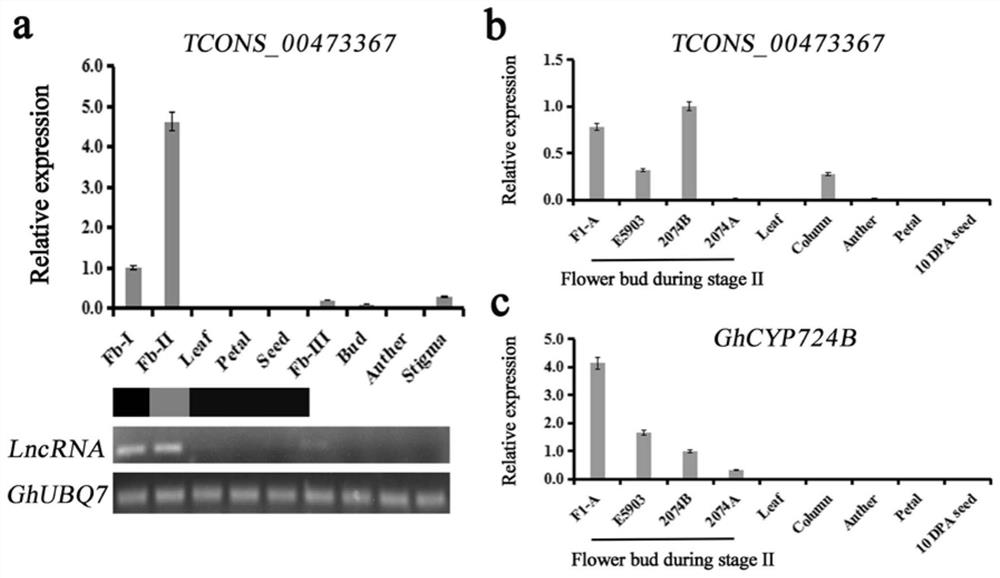Cotton pollen fertility related long-chain non-coding RNA and application of target gene of cotton pollen fertility related long-chain non-coding RNA
A long-chain non-coding and coding gene technology, applied in DNA/RNA fragments, applications, genetic engineering, etc.
- Summary
- Abstract
- Description
- Claims
- Application Information
AI Technical Summary
Problems solved by technology
Method used
Image
Examples
Embodiment 1
[0075] Example 1, TCONS_00473367 and its target gene GhCYP724B expression analysis
[0076] Step 11 Acquisition and preservation of different cotton materials and different tissues
[0077] First, take the fertile material 2074B (Su Mian 20; Liu et al., Over-expression of transcription factor GhWRI1 in upland cotton. Biologia Plantarum 2018.62:335-342. The public can obtain it from China Agricultural University) at the seedling stage (Leaf), spore Flower bud from primary cell stage to pollen mother cell stage (FB-I), flower bud from meiosis stage to binucleate stage (FB-II), flower bud at pollen grain mature stage (FB-III), flower bud the day before flowering (Bud), full flower stage Petals (Petal), stigmas at full flowering stage (Stigma), anthers at full flowering stage (Anther), and seeds 10 days after flowering (Seed) were used for TCONS_00473367 tissue-specific expression analysis. In addition, flower buds from meiosis to binucleate stage of male sterile line 2074A, flow...
Embodiment 2
[0094] Example 2. Cloning of cotton long-chain non-coding RNATCONS_00473367 and protein-coding gene GhCYP724B fragment and construction of VIGS vector
[0095]Total RNA was extracted from flower buds of Gossypium hirsutum L. (Gossypium hirsutum L.) cultivar Su cotton 20 (2074B) from meiosis to binucleate stage, and cDNA was obtained by reverse transcription. R and VIGS724-F / VIGS724-R were used as primers for PCR amplification.
[0096] The primer sequences for the above-mentioned PCR amplification are as follows:
[0097] Primer VIGS67-F: 5'-CCTTAGGAGAAGAGGATGATTCGCT-3';
[0098] Primer VIGS67-R: 5'-TTCATCATGAAATCACAGTGAACCT-3'.
[0099] Primer VIGS724-F: 5'-TGGATTCTTTATTGGGTGGC-3';
[0100] Primer VIGS724-R: 5'-CCTGAAGTTTTGAACAAGGTGG-3'.
[0101] For the above PCR primer sequences, a Spe I (ACTAGT) restriction site sequence was added to the 5' end of the upstream primer, and a Pac I (TTAATTAA) restriction site sequence was added to the 5' end of the downstream primer.
...
Embodiment 3
[0108] Example 3, virus-mediated gene silencing cotton TCONS_00473367 and GhCYP724B
[0109] Step 31 Construction of recombinant Agrobacterium
[0110] The recombinant plant expression vectors pCLCrVA-TCONS_00473367 and pCLCrVA-GhCYP724B prepared in Example 2, as well as the positive control vector pCLCrVA-CHLI, the empty vector pCLCrVA and the auxiliary vector pCLCrVB were transformed into Agrobacterium tumefaciens GV3101 competent cells by the freeze-thaw method. The above-mentioned competent cells were purchased from Beijing Tuoyingfang Technology Co., Ltd., and after shaking culture in YEP medium without antibiotics for 3-4 hours at 28°C, they were coated on a medium containing 50 μg / ml kanamycin sulfate and 50 μg / ml rifampicin. Screening and culturing in YEP solid culture; through colony PCR, the PCR is carried out using primers VIGS67-F / VIGS67-R and VIGS724-F / VIGS724-R in Example 2 respectively, and then identifying positive single clones will identify the correct agricu...
PUM
 Login to View More
Login to View More Abstract
Description
Claims
Application Information
 Login to View More
Login to View More - R&D
- Intellectual Property
- Life Sciences
- Materials
- Tech Scout
- Unparalleled Data Quality
- Higher Quality Content
- 60% Fewer Hallucinations
Browse by: Latest US Patents, China's latest patents, Technical Efficacy Thesaurus, Application Domain, Technology Topic, Popular Technical Reports.
© 2025 PatSnap. All rights reserved.Legal|Privacy policy|Modern Slavery Act Transparency Statement|Sitemap|About US| Contact US: help@patsnap.com



